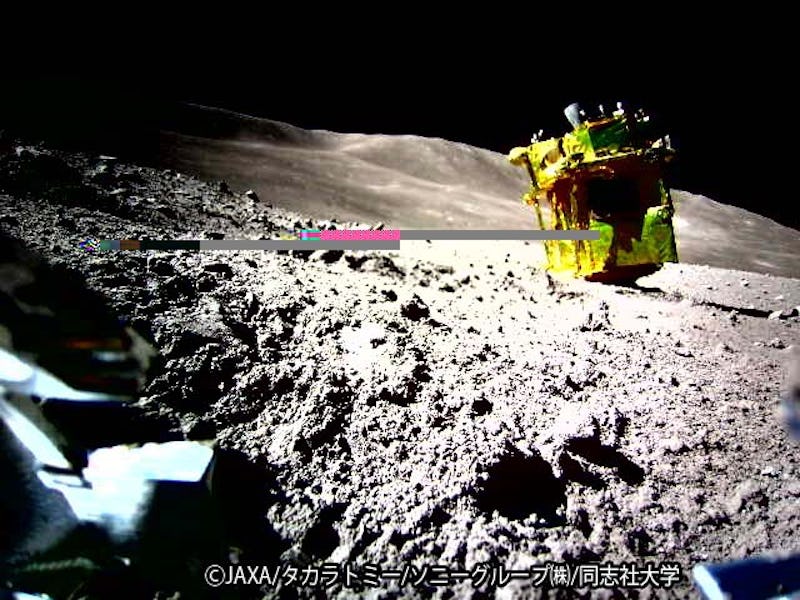Look: Japan’s SLIM Lander Sent Back These Charming Images Before Powering Off
JAXA released new images that show how SLIM is situated in its new home.

Last week, Japan became the fifth nation to successfully land on the Moon without crashing. Unfortunately, the historic touchdown left the Smart Lander for Investigating Moon (SLIM) positioned like a toy after a toddler is done playing with it: planted face down on the ground.
This less-than-ideal situation forced the Japan Aerospace Exploration Agency (JAXA) to power down the lander and save precious battery life. But before it did, SLIM was able to send some data back to Earth. Today, JAXA released new images that show how SLIM is situated in its new home.
The new data also confirmed Japan’s biggest hope for its SLIM project: a precise landing on the Moon within 100 meters of its target, confirming proof of concept.
JAXA rotated this image from its SLIM’s Multi-Band Camera “to align with the direction of gravity,” officials wrote on Thursday. The rover didn’t land as expected.
SLIM was designed to last just a few Earth days, JAXA officials wrote in a statement. But the mission will be drawn out for a month at least, to see if the angle of sunlight changes over time and perhaps strike SLIM’s landing site to sufficiently power its solar cells from its unintended westward orientation. The sunlight does a sort of angular reset on the Moon each Earth month (a day on the Moon lasts about one month on Earth).
While JAXA awaits those solar-cell results, SLIM’s Multi-Band Camera took a slanted image of Moon rocks nearby. In an annotated image, their names appear and seem to follow a canine theme. They have names like “St. Bernard,” “Bulldog,” “Toy Poodle,” plus Japanese breed-inspired names like “KAIKEN,” “AKITAINU,” “SHIBAINU.”
The JAXA team named several Moon rocks, and named them after dogs. The names are “with intent of communicating their relative sizes smoothly by the names,” officials wrote on Thursday.
There’ll be more, hopefully, if SLIM’s solar cells absorb enough energy, JAXA officials wrote. “Based on this landscape image, the team is sorting out rocks of interest, assigning a nickname to each of them, with the intent of communicating their relative sizes smoothly by the names,” the space agency shared. JAXA added that preparations are underway to “promptly conduct” high-resolution spectroscopy, a technique that extracts information from light, of Moon rocks once “SLIM recovers by the power generated by the solar array.”
SLIM’s peculiar position on the Moon’s surface appeared in imagery from one of its two tiny robotic passengers. Photo evidence came from JAXA’s collaboration with toy company Takara Tomy. Along with two other partners, Sony and Doshisha University in Kyoto, they created Lunar Excursion Vehicle 2 (LEV-2).
On Thursday, Daichi Hirnao (left), associate senior researcher at JAXA's Space Exploration Innovation Hub Center, explains an image of the lunar surface robot LEV-2, also known as SORA-Q.
Also known as SORA-Q, LEV-2 looks like a rolling ball. It comes from the minds behind the popular toy Transformers and would easily sit in the palm of your hand. This small robot and SLIM’s other rover, LEV-1, are Japan’s first rovers on the Moon. LEV-1 also has other laurels, too. It achieved successful direct communication with Earth from the Moon, according to JAXA. “This is considered as the world’s smallest and lightest case of direct data transmission from approximately 380,000 kilometers away,” space agency officials wrote in a recent statement.
JAXA will likely publish more updates in the near future to report the ongoing saga of SLIM’s solar cells.